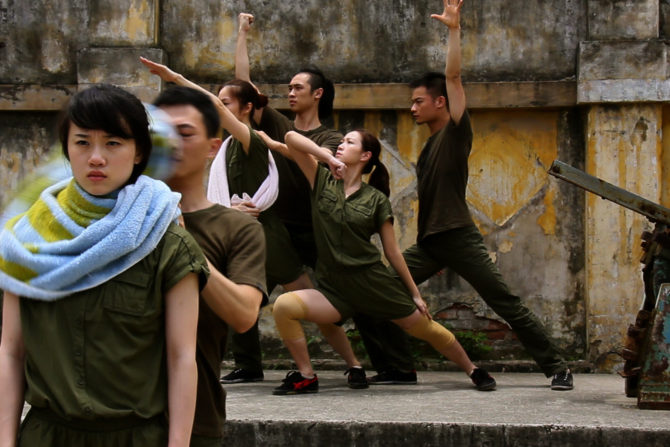Don’t know what “screendance” is? Video Corpo will soon enlighten you.
According to The International Journal of Screendance, the interdisciplinary art form is an amalgam of “dance, performance, visual art, cinema and media arts, drawing on their practices, technologies, theories and philosophies.” In other words, this isn’t The Nutcracker on home video.
Video Corpo, a screendance festival running Nov. 16 through Dec. 7, is the brainchild of three performance artists who want to make the art form accessible to Chicagoans.
Co-founder Michelle Kranicke described Video Corpo as “celebrating movement-based artists who have used film as an extension of their practice, and/or as an alternative corporeal perspective.
“As a longtime dancemaker myself, I wanted to work with other experimental presenters in Chicago to create a platform for movement-based artists to showcase their work beyond live performance and present multiple viewpoints of the body,” said Kranicke, who is also artistic director of Zephyr dance company and co-director of SITE/less, a new Noble Square performance space and one of Video Corpo’s three locations.
Kranicke and her two collaborators, Joseph Ravens of Defibrillator Gallery in Bridgeport and Julieanne Ehre of Pivot Arts in Edgewater, seek to introduce Chicago to a new way of watching dance — and places they can watch it. “We each want our audiences to know about the wonderful programming at other small experimental institutions throughout the city and hopefully, have them discover new and exciting neighborhoods they may not have known about.”
Though they worked together on the festival, Kranicke, Ravens and Ehre independently curated their own spaces. “Each institution [is] able to highlight its own unique qualities,” Kranicke said. Video Corpo will primarily focus on contemporary screendance artists, but SITE/less will also showcase the short films of Meredith Monk, considered a pioneer in the art form. “We wanted to present work by [Monk], an iconic practitioner in the field, to help viewers understand that time-based artists have been using film and video to shift perspective for a while,” Kranicke explained. “Dance for camera and movement on screen have a long history.”
Korean-American artist Marianne M. Kim is a prominent figure in said history. The Northwestern University graduate has won worldwide acclaim for her screendance works since 2004, when she received her MFA from the University of California at Los Angeles ( UCLA ). Kim’s video installations will be part of Video Corpo’s Nov. 16 opening at Defibrillator, and will play through the festival’s closing on Dec. 7.
“As a creator, I think about what it means to be a global citizen, making work through the lens of our humanity,” Kim said via phone from her home in Arizona. “Questioning our humanity, I think, [is] one of the starting points of making work.”
Defibrillator will run two Kim installations, shot in Guangzhou, a coastal city in South China, and in Taipei, Taiwan. Each installation covers global issues like the role of the worker in China, as well as universal truths like same-sex love. For both projects, Kim traveled to each location with “my gear and some semblance of a plan, and worked very quickly with the dancers,” she said. “We would have a short amount of time to shoot, and then I would come back to the United States and edit the footage here.”
Kim noticed some major differences in working with Eastern-trained dancers. “In [both] China and Taiwan, all dancers come through a conservatory model, so technique was very much in their foreground,” she said. “The idea of improvisation was very new to them, where in the States it’s very familiar. In their training, they have to move from ballet to modern, postmodern to actual Chinese folk and operatic dance. Being trained in postmodern Western dance theater, I was challenged to look at their precision and what else we can pull out of them.”
However, Kim said, the dancers were “incredibly rigorous” and eager to adapt. “Young dancers are so open and hungry. Video shoots are relentless and impossible, and I’m always so beholden to them for being willing to ask, ‘what’s going on?’ ‘How do you want me to move?'” She laughed. “Every time I would say, ‘one more time!’ They soon gave up on that idea.”
In creating both installations, Kim drew inspiration not from conventional dance films but what she called “gorgeous films.”
“I looked at Terrence Malick and [Andrei] Tarkovksy, my filmic heroes, and asked, how do they do it and how can I steal from them?” she said. “One of the fixed threads in Tarkovsky’s work is duration, the essence of real time. There aren’t a lot of fast edits. Malick’s early work has a lot of follow-cam that’s amazing, the way he moves with an actor.”
Though much of Kim’s work is more performance-based than film-based, “with these two installations I thought more in the sense of the cinematic aesthetic,” she said. “There isn’t dialogue, so how do we tell stories through our bodies, through our gaze and through the camera?”
ideo Corpo opens Friday, Nov. 16 at Defibrillator Gallery at the Zhou B Art Center, 1029 W. 35th St., and Saturday, Nov. 17 at 7 p.m. at SITE/less, 1250 W. Augusta Blvd., with installations at both locations through Dec. 7 ( visit each location’s website for hours ). Pivot Arts presents a film screening and panel discussion Friday, Nov. 30 at 7:30 p.m. at Chicago Filmmakers, 5720 N. Ridge Ave. Admission to each opening, and the screening and panel discussion, is a suggested $10 donation at the door. For more information, visit siteless.org, dfbrl8r.org or pivotarts.org .
